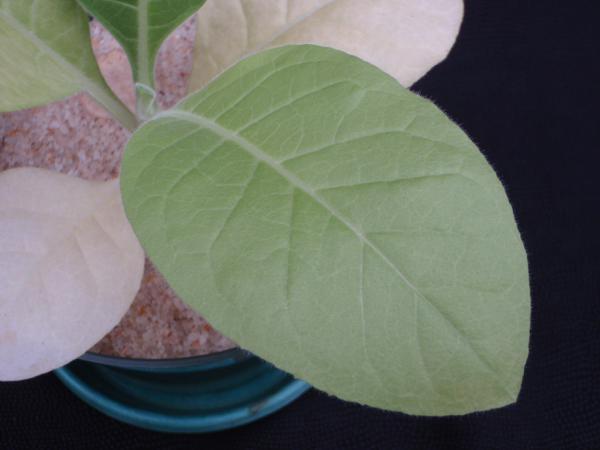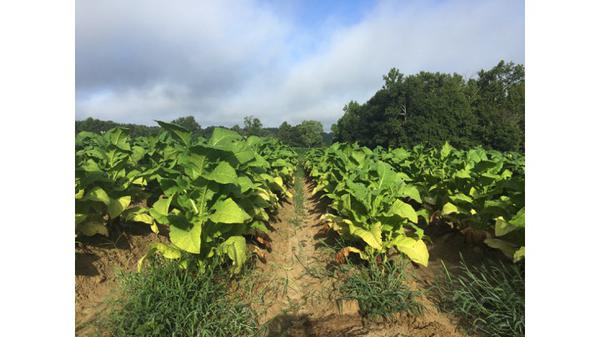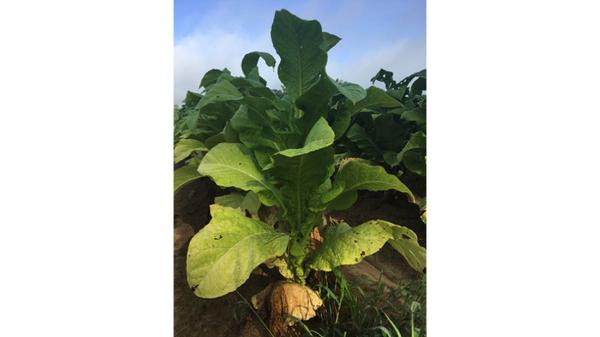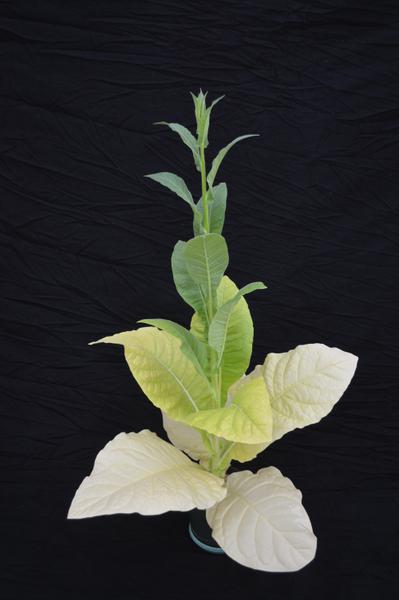Problem
Nutritional disorder – nitrogen (N) deficiency.
Symptoms
By far, nitrogen (N) is the most widely applied nutrient for plant growth. It should come as no surprise, that symptoms of nitrogen deficiency readily develop with tobacco plants.
In tobacco, one of the first indicators of limited nitrogen is stunted growth (Figure 1). Plant growth stalls and leaf expansion slows. Visual symptoms of nitrogen deficiency quickly follow. When nitrogen supplies are limited, the plant will reallocate nitrogen from the lower leaves to the upper leaves. This is possible due to the fact that nitrogen is a mobile element. This reallocation of nitrogen is the reason why symptoms initially develop on the lower foliage.
The initial symptom of nitrogen deficiency is a paler green coloration of the lower leaves (Figure 2). The progression to more advanced symptoms quickly develop when nitrogen is unavailable to the plant. Pale green leaves will begin to change to a light yellow, which becomes progressively more bleached over time (Figure 3). Ultimately, these bleach-yellow leaves will turn brown and fall off the plant (senesce).
Figure 4 and Figure 5 exhibit symptoms in the field. Figure 6 show a whole plant with advanced symptoms.
Similar Problems
Sulfur (S) deficiency also results in an overall yellowing of the leaves. Sulfur deficiencies first appear in the mid-section of the plant before progressing upward towards the growing tip. With severe deficiencies of sulfur, the lower leaves also become yellow. Tissue analysis for nutritional concentrations can assist with correctly diagnosing the problem.
Additional Information
Good root systems and environmental conditions that encourage nutrient uptake will aid in the uptake of nitrogen. Good root systems are promoted when soil nematode populations are low, pre-transplanting pesticide application is uniform, and when soil pH is above 5.8. Nitrogen application rates that are greater than required for field conditions will not overcome the negative effects of low soil pH.
Diagnostic Tips
Lower leaf yellowing and stunted growth helps to distinguish this disorder from sulfur deficiency. Submit a leaf sample for nutrient analysis.
Burley. The nitrogen sufficiency range for burley tobacco varies with growth stage, but the overall trend is higher levels in young plants as compared with mature plants. The nitrogen ranges are based on the most recently mature leaves and are: seedlings (4.0 to 6.0%), early growth (4.0 to 5.0%), flowering (3.5 to 4.5%) and maturity (3.0 to 4.0%).
Flue-cured. The recommended ranges for flue-cured tobacco are more refined. The nitrogen ranges based on the most recently mature leaves are: seedlings (4.0 to 6.0%), early growth (4.0 to 5.0%), flowering (3.5 to 4.5%) and maturity (2.25 to 3.0%). At harvest, sufficiency ranges for nitrogen are available for the upper leaf (2.0 to 2.25%), middle leaf (1.6 to 2.0%) and lower leaf (1.3 to 1.75%).
There are no published recommendations for excessive nitrogen levels. Too much nitrogen may increase yield slightly but may also make mechanical harvesting and curing more difficult, delay maturity, extend curing time, and result in more unripe cured leaf. Excessive nitrogen also stimulates sucker growth, which can lead to excessive use of maleic hydrazide (MH) and increase problems with hornworms and aphids. Nitrogen is also very leachable, and over application may contribute to groundwater contamination in deep, sandy soils.
Corrective Measures
Nitrogen deficiency is not uncommon in seasons marked by excessive early-to-midseason rainfall; therefore, corrective applications designed to account for leaching are sometimes necessary. Unfortunately, determining the correct amount to replace is one of the most difficult and risky tasks in tobacco production. A general guide to leaching adjustments for nitrogen is presented in Table 1. The amount of nitrogen to replace is expressed as a percentage of the suggested base rate that was applied before leaching occurred. If an excessive rate of nitrogen was applied prior to leaching, subtract the number of excess pounds from the number of replacement pounds calculated.
When choosing fertilizer sources for leaching adjustments, producers should consider sources absent of phosphorus because it leaches very little in the soil profile and can be expensive to purchase. For these reasons, producers are encouraged to apply fertilizer materials such as 13-0-14, 8-0-24, or other materials that contain nitrogen, potassium, sulfur, and magnesium. Another alternative is to mix equal amounts of K-Mag (0-0-22) and a 1:0:0 ratio sidedress material, such as 15.5-0-0 (calcium nitrate) or 27-0-0 (calcium ammonium nitrate). One final option would be to sidedress K-Mag and a liquid nitrogen fertilizer (such as 28% UAN) in separate applications, though this would require an additional trip across the field.
| Topsoil Depth | Estimated Water Percolated through Soil | Percentage of Applied Nitrogen to Replace After Transplantinga | ||
| 1-3 Weeks | 4-5 Weeks | 6-7 Weeks | ||
| Less than 10 inches to clay | 1 inch | 0 | 0 | 0 |
| 2 inches | 20 | 10 | 0 | |
| 3+ inches | 30 | 20 | 0 | |
| 10 to 16 inches to clay | 1 inch | 30 | 20 | 0 |
| 2 inches | 45 | 30 | 10 | |
| 3+ inches | 60 | 40 | 15 | |
| 17+ inches to clay | 1 inch | 50 | 25 | 15 |
| 2 inches | 75 | 35 | 20 | |
| 3+ inches | 100 | 45 | 20 | |
| a Apply about one pound of potassium (K2O) for each pound of nitrogen used as a leaching adjustment if the topsoil is deeper than 10 inches. | ||||
Management
Seedling Production. The symptoms of nitrogen deficiency in tobacco seedlings are identical to those observed during field production, though they are much more uncommon unless fertilizer application is greatly delayed or under applied. The quantity of applied nitrogen in the float system should total 250 ppm, with split fertilizer applications being utilized to deliver 100 to 150 ppm nitrogen per treatment. The first nitrogen application should take place 7-10 days after seeding and the second application 3 to 4 weeks later to reduce the potential for soluble salts injury. In addition, nitrogen concentration should never exceed 150 ppm in a single application.
Field Production. Soil analysis is not used to estimate the nitrogen rate needed for a specific tobacco field in North Carolina. Rather, the 50- to 80-pound-per-acre range shown on the soil test report is based on information from numerous field tests conducted across the state. In these tests, a base nitrogen rate of 50 to 80 pounds per acre has given consistently good results on most soils in most seasons. This is the total amount of nitrogen supplied by normal applications of the N-P-K fertilizer and the sidedresser but does not include additional nitrogen sometimes needed for leaching adjustments. The lower portion of the range is suggested for fine-textured (loam), fertile soils, especially where legumes such as soybeans or peanuts were grown the previous year. The higher portion of the range is suggested for coarse-textured (sandy) soils with topsoils deeper than 15 inches to clay.
Suggested nitrogen rates for several average topsoil depths are shown in Table 2. Determine your portion of the nitrogen rate range primarily by topsoil depth, or depth to clay. Fields with deeper, sandier topsoils usually are more leachable and contain less nitrogen as humic matter than those with shallower, more heavily textured topsoils. Generally, you should reduce the nitrogen rates shown by about 5 to 10 pounds per acre if the previous crop was a legume or the variety to be planted is known to mature late or cure poorly when overfertilized with nitrogen. Even greater nitrogen rate reductions may be needed on dark soils with 1 percent or more humic matter.
Also, when tobacco follows a heavily fertilized but poor corn crop (less than 75 bushels per acre), the residual nitrogen available for the tobacco may be as high as that left by soybeans or peanuts.
Only 15 pounds of extra nitrogen may reduce leaf quality, particularly in dry seasons. Both drought and excess nitrogen delay maturity and increase the amount of unripe tobacco. The first step to increasing the amount of ripe tobacco is to use a reasonable base nitrogen rate (particularly if irrigation is not available and mechanical harvesting is used), depending on topsoil depth, previous crop, variety to be grown, and experience. Also, be cautious and conservative with leaching adjustments for nitrogen. The second step is to delay harvest, if necessary, and make three or more primings so that each priming will have a high percentage of ripe leaves. The rate of ripening depends primarily on the amount and distribution of water, the nitrogen rate, soil type, and variety, so base your harvest rate on these factors, not on the calendar date or how fast your neighbor’s tobacco is being harvested.
The normal ripening process is caused by partial nitrogen starvation, which should begin about topping time. Therefore, nitrogen in the soil should be nearly depleted by flowering. Over application of nitrogen, prolonged drought, or both extend nitrogen uptake beyond topping time and therefore delay ripening because the crop is still absorbing nitrogen. Leaves harvested when they are high in nitrogen are more difficult to cure and often turn dark at the end of yellowing and into the early leaf-drying stage. This problem is increased by dry, hot conditions, which cause the leaves to appear riper than they really are.
| Topsoil Depth (inches) | Nitrogen Rate1 (pounds per acre) |
| 5 | 50 |
| 10 | 60 |
| 15 | 70 |
| 20+ | 80 |
| 1 Does not include leaching adjustments. | |
Funding Source
Funding was provided in part by the North Carolina Tobacco Foundation.
Project Team
Josh Henry (NC State M.S. student in Horticultural Science), Paul Cockson (NC State B.S. student in Agroecology), Ingram McCall (Research Technician in Horticultural Science), Rhonda Conlon and Rob Ladd (Extension IT at NC State), Matthew Vann (Tobacco Extension Specialist, Dept. of Crop and Soil Sciences), and Brian Whipker (Professor of Floriculture and Plant Nutrition in Horticultural Science).
Publication date: Jan. 1, 2017
NC Cooperative Extension prohíbe la discriminación por raza, color, nacionalidad, edad, sexo (incluyendo el embarazo), discapacidad, religión, orientación sexual, identidad de género, información genética, afiliación política, y estatus de veteran.
The use of brand names in this publication does not imply endorsement by NC State University or N.C. A&T State University of the products or services named nor discrimination against similar products or services not mentioned.
Recommendations for the use of agricultural chemicals are included in this publication as a convenience to the reader. The use of brand names and any mention or listing of commercial products or services in this publication does not imply endorsement by NC State University or N.C. A&T State University nor discrimination against similar products or services not mentioned. Individuals who use agricultural chemicals are responsible for ensuring that the intended use complies with current regulations and conforms to the product label. Be sure to obtain current information about usage regulations and examine a current product label before applying any chemical. For assistance, contact your local N.C. Cooperative Extension county center.
N.C. Cooperative Extension prohibits discrimination and harassment regardless of age, color, disability, family and marital status, gender identity, national origin, political beliefs, race, religion, sex (including pregnancy), sexual orientation and veteran status.






